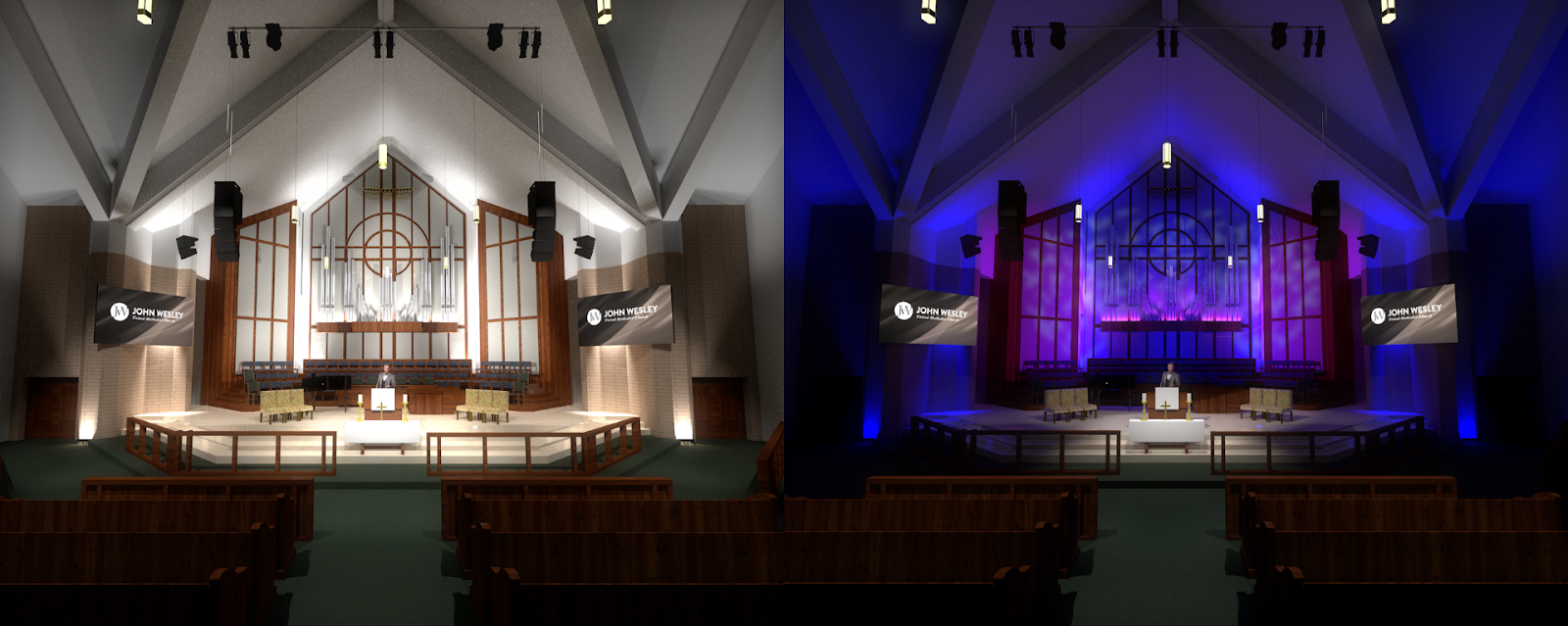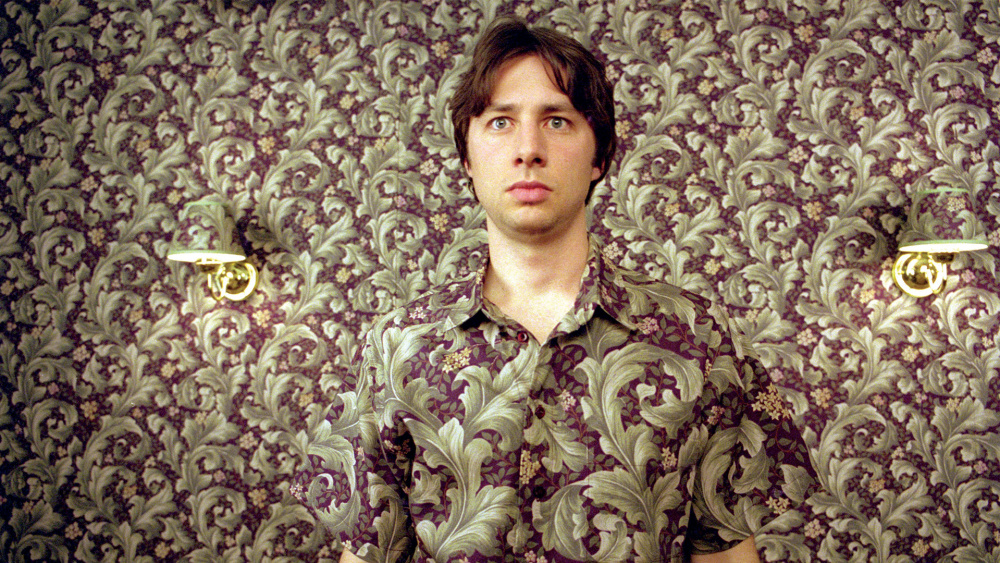When it comes to church technology, lighting tends to be a weak area for most worship leaders and church techs. It probably stems from the fact that sound systems have been in churches for decades, and video made its big move into the church world around the turn of the Millenium. Stage lighting has only recently become a hot topic of conversation, but it really is a necessary tool of modern worship.

We’d like to offer you some tips on how to use a stage lighting system like a pro.
Be Intentional About Where You Draw The Focus
The human eye is naturally oriented toward the brightest, highest-contrast thing in the room. Look around you now, and you’ll notice that when you relax your focus your eyes are naturally drawn to a window, light fixture, or in many cases a TV or monitor.
That’s one of the reasons we tend to look people in the eye when we talk to them. It’s also a big reason the fashion and cosmetics industries put so much effort into eyeliner and mascara. Our eyes include a dark iris next to the white sclera outlined by dark eyelashes. For most people, the eyes are the part of the face with the highest visual contrast, so that’s where we tend to focus naturally. It’s just how we’re wired.

It’s the same for your congregation. They are naturally going to focus on whatever is the brightest and highest-contrast thing in the room. That means that if a window is brighter than your pastor is lit on stage, it’s going to take effort to maintain focus during the teaching time. Conversely, if the speaker on stage is lit effectively, it will take effort to look away.
It’s also worth noting that color factors into this equation as well. A person wearing a beige suit in front of a beige wall is going to be much more difficult to keep your eye on than they would be on a blue background. These two colors are on opposite ends of the spectrum, and that translates to a higher degree of color contrast.

So the rule of thumb is to always examine each stage-look and ask the question, “Where do I want people to focus?” Once you know that, make sure to light the stage accordingly.
Provide Enough Light For The Task At Hand
There are typically two reasons you light the stage.
- You need to provide light for the people in the room.
- If you’re recording, streaming, or broadcasting services you have to provide enough light for cameras to capture a quality image.

Your eye works a lot like a camera. Your brain adjusts your pupil (the iris or aperture on a camera) to let more or less light in depending on the scene. The light falls onto the optic nerve in the back of your eye (the sensor in a camera), and your brain then interprets the image. If your pupil is wide open, and the image is still too dark for your brain to interpret, it simply turns up the sensitivity of the optic nerve (like increasing ISO or gain on a camera) until you can see clearly.
So how bright should a stage be lit?
If your subject is a person speaking on stage, you typically want to achieve around 80-100 fC of front lighting (a foot candle is a basic measurement of light intensity used in the lighting design world). At this level, colors come to life and most people will agree that the subject is well lit. In many cases, 80fC is as bright as you can go without getting complaints from the people on stage. In case you’re wondering, you will need a light meter that can provide measurements in either fC or lux to determine these levels.
For most modern cameras, you’ll need a minimum of 50 fC to achieve an acceptable image. In the 80-100fC range, you’ll find that even inexpensive cameras can perform well and will deliver a high degree of image quality.
Use Color Wisely
The advent of LED lighting has drastically changed the way stages are lit in churches. The ability to change colors instantly at the touch of a button has revolutionized lighting design, but it can be really easy to overdo it. Most color combinations are only going to incorporate two or three colors before things start getting out of hand.
To expand on that point, lighting designers should put thought into how the video displays blend with the lighting system. Think of the stage area as a canvas. All of the elements should work together as a unified look.
It’s also important to note that in the Church world, for whatever reason we typically don’t use color for front lighting of people. It’s just an unspoken norm that we see across the industry. You’d be well-advised to consider that as you develop your lighting looks.
Finally, if you’re lighting with a camera in mind, understand that blues are going to give you the blues. Most camera sensors are very good at rendering greens and reds, but blues can present a challenge on the lower end of the price range. Be sure to check your scene as you go because many shades of cyan and purple will render as plain old blue on your broadcast. It’s not your fault. It’s just something you have to work around.
Turn Off Fixtures When You Aren’t Using Them
This one probably seems pretty obvious, but we see it all the time. In the world of incandescent lights, it was easy to turn all the dimmers down to zero and walk away at the end of the service. With LED and moving head intelligent fixtures, it’s not so easy.
These fixtures operate off of constant power provided by non-dimmed circuits. When you pull the sliders down to zero you may be turning off the light engine but leaving the fixture running. This practice will greatly shorten the life expectancy of your fixtures because the fans and power supply are operating 24/7, heating up components and sucking in dust throughout the days between Sundays.

There are a few approaches to solving this problem. On the low-tech end, we see some churches simply flipping the breakers for the circuits powering the intelligent fixtures. More elegant approaches include DMX-controlled relays that enable operators to power the fixtures on and off from the lighting console. In many cases, systems that include conventional dimmers can be switched into a relay mode that provides non-dimmed power.
Whatever approach you choose, make sure you’re powering these fixtures off at the end of the day.
Be SURE to Check The Rigging!
Almost every time I ask a worship pastor when was the last time they inspected the rigging for their lighting system they look at me like they have no idea what I’m talking about. It really is scary to think how many lights, speakers, projectors, and other pieces of equipment are hanging above pastors' heads and to know that none of the rigging has been inspected since it was installed.
Let’s be clear… Anything that is hanging from your ceiling should be inspected at least once a year.
Rigging tends to get loose over time. It may be hard to believe, but I can’t count the number of times I’ve gone up to adjust a light only to realize that the c-clamp has gotten so loose that it just falls right off into my hand.
Please check your rigging regularly. Falling equipment is a nightmare. You don’t want to be responsible for somebody getting hurt.
Takeaway
Lighting blends Creativity and Science - but it takes practice and intentionality. It paints the picture that the congregation sees for your service. By following a few best practices and simple tricks of the trade, you can take full advantage of the system in place. And when you max out your system and need more, let us know! We would love to help design an upgraded Lighting System to match the needs and style of your church.